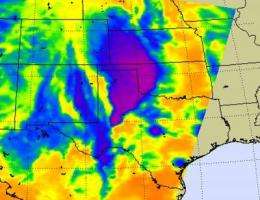Infrared NASA satellite data indicates severe weather for south central US this week

Infrared and microwave satellite imagery from NASA have been providing forecasters at the National Weather Service valuable data on weather system that has potential to bring severe weather to the south central U.S. over the next several days.
A large upper-level storm system is approaching central Oklahoma and moving east, into eastern Oklahoma and western Arkansas, bringing the threat of heavy rain, gusty winds, and tornadoes.
Severe thunderstorm warnings were posted early on March 19 in Oklahoma, Kansas and Texas. Oklahoma also has a flash flood warning centered on Oklahoma City. Texas had a tornado warning near Midland earlier in the day.
The National Weather Service issued warnings today, March 19, 2012 for eastern Oklahoma and western Arkansas which stated
"Dangerous/potentially life-threatening flooding is expected." Forecasters at the National Weather Service expect 4 to 8 inch rainfall totals through Wednesday, March 21, and possibly moderate and major river flooding. For more information on the warnings, visit: www.srh.noaa.gov/tsa/dsp/dsp.php. For the audio version of the National Weather Service forecast for eastern Oklahoma and northwestern Arkansas, visit: http://www.srh.noaa.gov/images/rtimages/tsa/crs/mp3/OKCHAZARD.mp3.
Edward Olsen of NASA's Jet Propulsion Laboratory in Pasadena, Calif. creates imagery using data from the Atmospheric Infrared Sounder (AIRS) instrument that flies onboard NASA's Aqua satellite. Olsen created imagery from a satellite overpass during the morning hours today, March 19. He said, "The infrared and microwave images show the early phase of the convection blow-up."
A movie was created using infrared and visible data from NOAA's GOES-13 satellite from March 17 to March 19 at 1740 UTC (1:40 p.m. EST). When the AIRS data was matched with the GOES satellite animation, the blow-up of convection (rising air that forms thunderstorms) appears to have begun around 0245 UTC on March 19 (10:45 p.m. EST on March 18). In the satellite movie, the strong front comes together and resembles an upside-down arrow at the end of the animation on March 19.
GOES-13 is operated by the National Oceanic and Atmospheric Administration and the movie was created by NASA's GOES Project, located at NASA's Goddard Space Flight Center, Greenbelt, Md.
"The line on the Eastern edge of the active region is well established by the time of the AIRS overpass images (at 0853 UTC on March 19)," Olsen said. In the AIRS infrared image, strong convection (strongest on the eastern/leading edge) and cold cloud tops extend from Midland, Texas over the Texas Panhandle and Western Oklahoma and Kansas. The AIRS infrared image on March 19 at 0853 UTC (4:53 a.m. EST) showed cloud top were colder than -63F/-52.7C, indicating strong, high thunderstorm cloud tops that reached high up into the troposphere.
The NASA microwave imagery showed that the strongest convection and likely heavy precipitation was taking place in Oklahoma, just to the east of the Texas/Oklahoma border North of where I-40 crosses that border.
Severe weather is expected in that part of the country over the next couple of days and NASA and NOAA satellites continue to provide forecasters with valuable data.
Provided by NASA's Goddard Space Flight Center



















